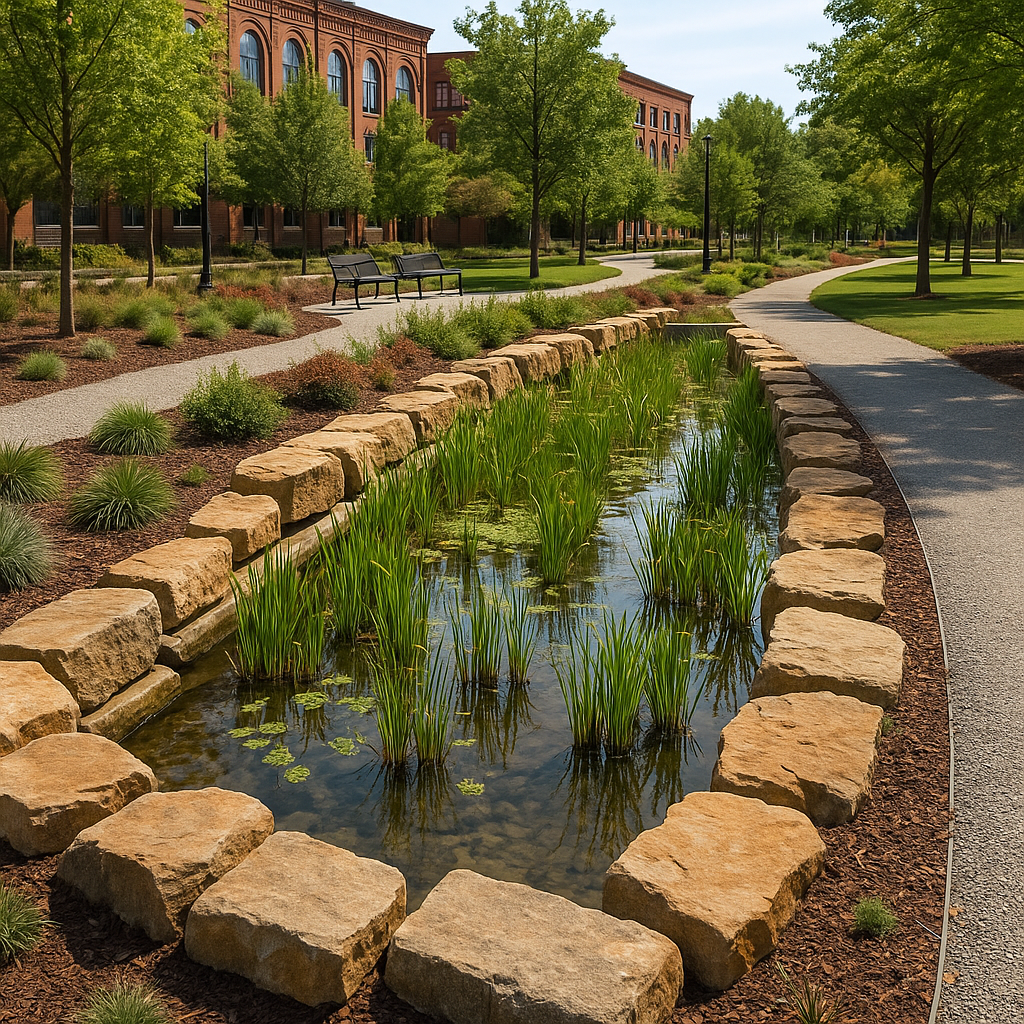As cities and communities face the growing challenges of climate change, urban heat, and water management, green infrastructure has emerged as a powerful solution. At the heart of many successful green infrastructure projects is a beautiful landscape that combines ecological resilience with aesthetic appeal. These landscapes not only address environmental concerns but also provide valuable public spaces that support wellness, biodiversity, and civic pride.
This article explores how landscape design architecture contributes to green infrastructure projects. We examine design strategies, sustainability practices, and collaborative approaches that ensure both function and beauty in civic and commercial developments.
What Is Green Infrastructure?
Green infrastructure refers to the use of natural processes and systems to manage environmental challenges, especially in urban areas. These include:
- Bioswales and rain gardens
- Permeable pavements
- Urban forests and green roofs
- Wetland restoration
- Native planting zones
Incorporating a beautiful landscape into these solutions enhances their effectiveness and ensures they are embraced by the public.
The Role of Landscape Design in Green Infrastructure
Enhancing Public Engagement and Acceptance
Projects that look appealing are more likely to receive public support and ongoing maintenance funding. Aesthetic elements transform green infrastructure into community assets.
Blending Function and Form
Professionally planned landscape design ensures that green infrastructure performs its ecological function while also serving as an attractive visual and recreational space.
Connecting Urban and Natural Systems
Landscape contractors play a key role in integrating ecological features with existing infrastructure such as roadways, utility corridors, and building edges.
Designing a Beautiful Landscape for Green Infrastructure
Begin with a Comprehensive Landscape Drawing
Every successful green project begins with a site-specific landscape drawing that outlines:
- Water flow patterns and retention zones
- Plant groupings and seasonal bloom schedules
- Grading and drainage contours
- Seating, lighting, and signage placement
Use Native and Adaptive Plants
Native species require less maintenance, tolerate local climate, and support pollinators and wildlife. This contributes to beautiful landscape sustainability and biodiversity.
Create Layered Planting Schemes
Layering grasses, shrubs, and trees improves soil health, filters pollutants, and creates dynamic visual interest throughout the year.
Add Functional Hardscapes
Use permeable pavers, stone outcrops, and boardwalks to enhance accessibility while supporting drainage and erosion control.
Explore pedestrian integration in Beautiful Landscape Walkways for Safer Public Spaces.
Green Infrastructure Features That Elevate Landscape Design
Rain Gardens
Rain gardens absorb and filter stormwater runoff from rooftops and pavement. They can be visually enhanced with sculptural basins, stone edging, and flowering perennials.
Green Roofs
Vegetated rooftops reduce building heat and stormwater runoff. Incorporate seating and walking paths for building occupants to enjoy urban greenery.
Bioswales and Retention Basins
These are designed to slow and clean water flow. Native grasses and flowering plants make them visually appealing and ecologically functional.
Tree Canopies and Urban Forests
Tree planting combats the urban heat island effect while providing shade, beauty, and carbon absorption.
Seating and Rest Areas in Green Infrastructure
Well-placed seating invites interaction with green infrastructure features and transforms functional spaces into leisure destinations. Integrate:
- Shaded benches along bioswales
- Picnic tables near rain gardens
- Naturalistic seating like boulders or timber slabs
Learn how to design these spaces in Beautiful Landscape Seating Areas for Relaxed Breaks.
Case Study Elements: Parks, Plazas, and Stormwater Management
Many municipalities are combining parks and plazas with stormwater systems to create dual-purpose spaces. These feature:
- Amphitheaters bordered by rain gardens
- Sculptural fountains that double as retention features
- Walking paths lined with educational signage on sustainability
See these principles in action in Beautiful Landscape for Parks and Public Plazas.
Working with Landscape Contractors on Green Projects
Site Evaluation and Hydrology Analysis
Professional landscape contractors assess slopes, soil types, and water behavior to select the best green infrastructure elements for your site.
Compliance with Environmental Standards
Contractors ensure adherence to stormwater ordinances, erosion control mandates, and native plant use requirements.
Construction and Maintenance Expertise
From excavation to planting to irrigation, experienced contractors bring your vision to life and support long-term upkeep.
Final Thoughts
A beautiful landscape is essential for the success of green infrastructure. When ecological engineering is combined with thoughtful landscape design architecture, the result is both impactful and inspiring. By investing in beauty, communities strengthen environmental resilience, enhance public health, and elevate civic identity.
Through detailed landscape drawings, collaboration with skilled landscape contractors, and a commitment to sustainability, developers and municipalities can build future-ready spaces where nature and people thrive together.

